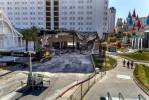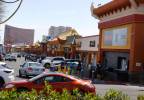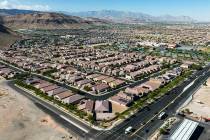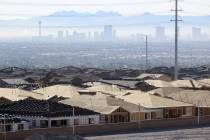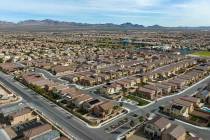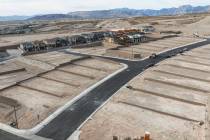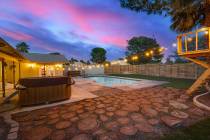Does home building rise suggest industry turnaround?
WASHINGTON — A surge in apartment construction gave homebuilders more work in November. And permits, a gauge of future construction, rose largely because of a jump in apartment permits.
Some analysts say the gains, though coming off extremely low levels, suggest the depressed housing industry may have reached a turning point.
Economists now say 2011 will be the first year since the Great Recession began in 2007 that home construction will have helped the economy grow. Before this year, the industry endured two of the worst years ever.
“Homebuilding is through the worst and is now steadily improving,” said Paul Diggle, a property economist at Capital Economics.
Builders broke ground on a seasonally adjusted annual rate of 685,000 homes in November, a 9.3 percent jump from October, the government said Tuesday. It’s the highest level since April 2010.
Still, the rate is far below the 1.2 million homes that economists say would be built each year in a healthy housing market.
Construction of single-family homes rose 2.3 percent in November to a seasonally adjusted annual rate of 447,000. Apartment construction jumped 32 percent to a rate of 238,000 units. Single-family homes account for about 70 percent of homebuilding.
For the year, work is expected to have begun on 430,000 single-family homes and 185,000 apartments. Those figures remain far below the roughly 840,000 single-family homes and 360,000 apartments that would be started in a healthy economy.
‘More fallout, more darkness’
Las Vegas-based SalesTraq reported 250 new-home permits issued in Clark County in November, a 64 percent spike from 152 in the same month a year ago. However, the year-to-date total of 3,356 permits is far below last year’s total of 4,380, which was up from 3,776 the previous year.
“I’m not sure this problem with housing is going to get better anytime soon,” SalesTraq president Larry Murphy said.
Murphy predicted a few months ago that Las Vegas is only about halfway through the foreclosure crisis, with another 100,000 foreclosures yet to come, based on 60 percent of Las Vegas homeowners being “upside-down” on home equity and 17,000 bank repossessions in each of the last two years.
“I’m starting to get the feeling that people in this country are so fed up with Wall Street and the government,” he said. “There may be more fallout, more darkness in the housing market.”
Multifamily construction is expected to add just 680 units to the rental stock in Las Vegas in 2011, following a year with inventory growth of more than 1,500 units, according to a fourth-quarter market report from brokerage Marcus & Millichap.
The 430-unit Veritas apartments in Henderson is the only development slated to come on line by year’s end, which will expand the inventory by 0.3 percent, the report said. Although the metro’s apartment planning pipeline consists of 2,157 units, none of the developments under consideration contain firm start dates.
Still, Tuesday’s national home construction data, along with encouraging economic news out of Germany and Spain, helped fuel a huge rally on Wall Street. The Dow Jones industrial average jumped 337 points.
Patrick Newport and Michelle Valverde, U.S. economists at IHS Global Insight, said the better-than-expected figures show that the housing industry is “finally getting off the mat.”
“It’ll keep getting better through next year,” T. Rowe Price associate economist Jared Franz said.
Last year, builders began work on roughly 587,000 homes.
That barely surpassed the 554,000 homes started in 2009, the worst year ever.
Though new homes represent just
20 percent of the overall home market, they have an outsized impact on the economy. Each home built creates an average of three jobs for a year and generates about $90,000 in taxes, according to the National Association of Home Builders.
A shift toward renting
Renting has become a preferred option for many Americans who lost their jobs during the recession and were forced to leave their houses. The surge in apartments has provided a lift to the beleaguered housing market but has not been enough to completely offset the loss of single-family homes.
Permits rose 5.7 percent last month to a seasonally adjusted annual rate of 681,000, boosted by a 16 percent jump in permits for apartment buildings, to 246,000.
Builders typically begin construction on single-family homes six months after getting a permit. With apartment projects, the lag time can be up to a year.
Over the past year, permits for apartment buildings with five or more units have surged more than 80 percent. Permits for single-family homes have risen much less: just 3.6 percent.
Demand for new homes is weak. Record-low mortgage rates and plunging home prices have done little to help.
The chief problem: Builders are struggling to compete with deeply discounted foreclosures and short sales.
Short sales occur when lenders allow homes to be sold for less than what’s owed on the mortgage. Few homes are selling.
In October, sales of new homes rose slightly, largely because builders cut their prices in the face of weak demand. Sales hit a six-month low in August. And this year is shaping up to be the worst since the government began keeping records a half-century ago.
Sales have also fallen because previously occupied homes have become a better deal than new homes. The median price of a new home is about 30 percent higher than the median price for a resale. That’s nearly twice the markup typical in a healthy housing market.
Las Vegas Review-Journal writer Hubble Smith contributed to this report.



